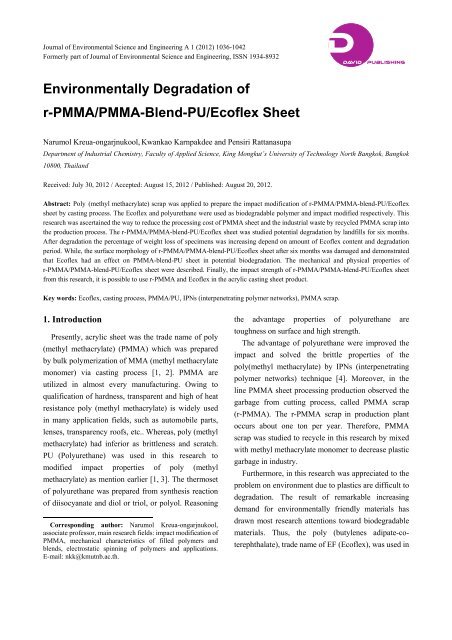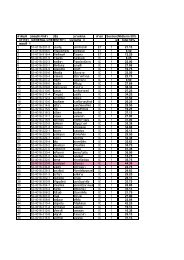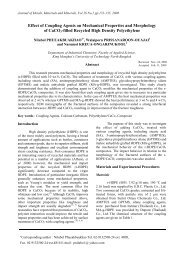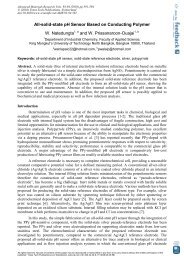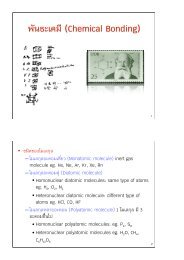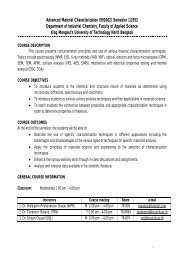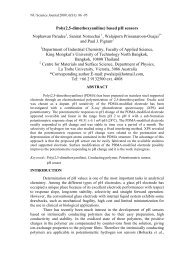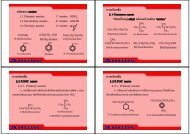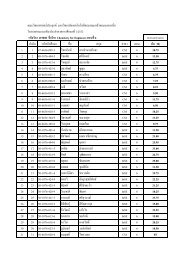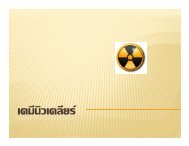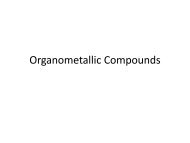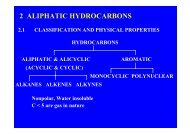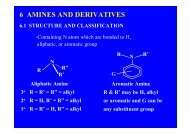Environmentally Degradation of r-PMMA/PMMA-Blend-PU/Ecoflex ...
Environmentally Degradation of r-PMMA/PMMA-Blend-PU/Ecoflex ...
Environmentally Degradation of r-PMMA/PMMA-Blend-PU/Ecoflex ...
Create successful ePaper yourself
Turn your PDF publications into a flip-book with our unique Google optimized e-Paper software.
Journal <strong>of</strong> Environmental Science and Engineering A 1 (2012) 1036-1042<br />
Formerly part <strong>of</strong> Journal <strong>of</strong> Environmental Science and Engineering, ISSN 1934-8932<br />
D<br />
DAVID<br />
<strong>PU</strong>BLISHING<br />
<strong>Environmentally</strong> <strong>Degradation</strong> <strong>of</strong><br />
r-<strong>PMMA</strong>/<strong>PMMA</strong>-<strong>Blend</strong>-<strong>PU</strong>/Ec<strong>of</strong>lex Sheet<br />
Narumol Kreua-ongarjnukool, Kwankao Karnpakdee and Pensiri Rattanasupa<br />
Department <strong>of</strong> Industrial Chemistry, Faculty <strong>of</strong> Applied Science, King Mongkut’s University <strong>of</strong> Technology North Bangkok, Bangkok<br />
10800, Thailand<br />
Received: July 30, 2012 / Accepted: August 15, 2012 / Published: August 20, 2012.<br />
Abstract: Poly (methyl methacrylate) scrap was applied to prepare the impact modification <strong>of</strong> r-<strong>PMMA</strong>/<strong>PMMA</strong>-blend-<strong>PU</strong>/Ec<strong>of</strong>lex<br />
sheet by casting process. The Ec<strong>of</strong>lex and polyurethane were used as biodegradable polymer and impact modified respectively. This<br />
research was ascertained the way to reduce the processing cost <strong>of</strong> <strong>PMMA</strong> sheet and the industrial waste by recycled <strong>PMMA</strong> scrap into<br />
the production process. The r-<strong>PMMA</strong>/<strong>PMMA</strong>-blend-<strong>PU</strong>/Ec<strong>of</strong>lex sheet was studied potential degradation by landfills for six months.<br />
After degradation the percentage <strong>of</strong> weight loss <strong>of</strong> specimens was increasing depend on amount <strong>of</strong> Ec<strong>of</strong>lex content and degradation<br />
period. While, the surface morphology <strong>of</strong> r-<strong>PMMA</strong>/<strong>PMMA</strong>-blend-<strong>PU</strong>/Ec<strong>of</strong>lex sheet after six months was damaged and demonstrated<br />
that Ec<strong>of</strong>lex had an effect on <strong>PMMA</strong>-blend-<strong>PU</strong> sheet in potential biodegradation. The mechanical and physical properties <strong>of</strong><br />
r-<strong>PMMA</strong>/<strong>PMMA</strong>-blend-<strong>PU</strong>/Ec<strong>of</strong>lex sheet were described. Finally, the impact strength <strong>of</strong> r-<strong>PMMA</strong>/<strong>PMMA</strong>-blend-<strong>PU</strong>/Ec<strong>of</strong>lex sheet<br />
from this research, it is possible to use r-<strong>PMMA</strong> and Ec<strong>of</strong>lex in the acrylic casting sheet product.<br />
Key words: Ec<strong>of</strong>lex, casting process, <strong>PMMA</strong>/<strong>PU</strong>, IPNs (interpenetrating polymer networks), <strong>PMMA</strong> scrap.<br />
1. Introduction <br />
Presently, acrylic sheet was the trade name <strong>of</strong> poly<br />
(methyl methacrylate) (<strong>PMMA</strong>) which was prepared<br />
by bulk polymerization <strong>of</strong> MMA (methyl methacrylate<br />
monomer) via casting process [1, 2]. <strong>PMMA</strong> are<br />
utilized in almost every manufacturing. Owing to<br />
qualification <strong>of</strong> hardness, transparent and high <strong>of</strong> heat<br />
resistance poly (methyl methacrylate) is widely used<br />
in many application fields, such as automobile parts,<br />
lenses, transparency ro<strong>of</strong>s, etc.. Whereas, poly (methyl<br />
methacrylate) had inferior as brittleness and scratch.<br />
<strong>PU</strong> (Polyurethane) was used in this research to<br />
modified impact properties <strong>of</strong> poly (methyl<br />
methacrylate) as mention earlier [1, 3]. The thermoset<br />
<strong>of</strong> polyurethane was prepared from synthesis reaction<br />
<strong>of</strong> diisocyanate and diol or triol, or polyol. Reasoning<br />
Corresponding author: Narumol Kreua-ongarjnukool,<br />
associate pr<strong>of</strong>essor, main research fields: impact modification <strong>of</strong><br />
<strong>PMMA</strong>, mechanical characteristics <strong>of</strong> filled polymers and<br />
blends, electrostatic spinning <strong>of</strong> polymers and applications.<br />
E-mail: nkk@kmutnb.ac.th.<br />
the advantage properties <strong>of</strong> polyurethane are<br />
toughness on surface and high strength.<br />
The advantage <strong>of</strong> polyurethane were improved the<br />
impact and solved the brittle properties <strong>of</strong> the<br />
poly(methyl methacrylate) by IPNs (interpenetrating<br />
polymer networks) technique [4]. Moreover, in the<br />
line <strong>PMMA</strong> sheet processing production observed the<br />
garbage from cutting process, called <strong>PMMA</strong> scrap<br />
(r-<strong>PMMA</strong>). The r-<strong>PMMA</strong> scrap in production plant<br />
occurs about one ton per year. Therefore, <strong>PMMA</strong><br />
scrap was studied to recycle in this research by mixed<br />
with methyl methacrylate monomer to decrease plastic<br />
garbage in industry.<br />
Furthermore, in this research was appreciated to the<br />
problem on environment due to plastics are difficult to<br />
degradation. The result <strong>of</strong> remarkable increasing<br />
demand for environmentally friendly materials has<br />
drawn most research attentions toward biodegradable<br />
materials. Thus, the poly (butylenes adipate-coterephthalate),<br />
trade name <strong>of</strong> EF (Ec<strong>of</strong>lex), was used in
<strong>Environmentally</strong> <strong>Degradation</strong> <strong>of</strong> r-<strong>PMMA</strong>/<strong>PMMA</strong>-<strong>Blend</strong>-<strong>PU</strong>/Ec<strong>of</strong>lex Sheet 1037<br />
this research as a biodegradable polymer. The<br />
molecular structure <strong>of</strong> EF is shown in Fig. 1. Also the<br />
interesting property <strong>of</strong> EF is able biodegradable in<br />
environment [5]. Moreover, structure <strong>of</strong> EF might be<br />
contributed to increase the impact property <strong>of</strong> poly<br />
(methyl methacrylate).<br />
The objective <strong>of</strong> this research was to prepare<br />
r-<strong>PMMA</strong>/<strong>PMMA</strong>-blend-<strong>PU</strong>/Ec<strong>of</strong>lex sheet by bulk<br />
polymerization via casting process. The mechanical<br />
and physical properties <strong>of</strong> r-<strong>PMMA</strong>/<strong>PMMA</strong>blend-<strong>PU</strong>/Ec<strong>of</strong>lex<br />
sheet were also investigated. Finally,<br />
r-<strong>PMMA</strong>/<strong>PMMA</strong>-blend-<strong>PU</strong>/Ec<strong>of</strong>lex sheet was studied<br />
an effect <strong>of</strong> biodegradable polymer, EF on potential<br />
biodegradation to r-<strong>PMMA</strong>/<strong>PMMA</strong>- blend-<strong>PU</strong> sheet,<br />
which can use for industry.<br />
2. Experiment<br />
2.1 Materials<br />
Methyl methacrylate monomer (MMA monomer),<br />
linear glycol adipate polyester polyol (T2000),<br />
Aliphatic hexamethylene diisocyanate, Azo-bis-2,4-<br />
dimethyl valeronitrile, EGDM (ethylene glycol<br />
dimethacrylate) and dibutyl tin laurate (DBTL) were<br />
supplied by PAN ASIA Industry Co., Ltd., Chlor<strong>of</strong>orm<br />
and petroleum ether were purchased from Labscan<br />
Asia Co., Ltd and Fisher Scientific respectively.<br />
Ec<strong>of</strong>lex F BX 7011: (BASF Co., Ltd) was obtained<br />
from National MTEC (Metal and Materials<br />
Technology Center). All <strong>of</strong> these chemicals were used<br />
without further purification.<br />
2.2 Preparation <strong>of</strong> r-<strong>PMMA</strong>/<strong>PMMA</strong>-<strong>Blend</strong>-<strong>PU</strong>/Ec<strong>of</strong>lex<br />
Sheet<br />
The radical bulk polymerization <strong>of</strong><br />
r-<strong>PMMA</strong>/<strong>PMMA</strong>-blend-<strong>PU</strong>/Ec<strong>of</strong>lex sheet was<br />
prepared from r-<strong>PMMA</strong> dissolved in MMA monomer.<br />
The ratio <strong>of</strong> MMA:r-<strong>PMMA</strong>:<strong>PU</strong> was used to prepared<br />
r-<strong>PMMA</strong>/<strong>PMMA</strong>-blend-<strong>PU</strong>/Ec<strong>of</strong>lex sheet were<br />
72:3:25 and 71:4:25 [6] under viscous agitation. The<br />
EF was dissolved in chlor<strong>of</strong>orm and added to MMA<br />
monomer, variable amount <strong>of</strong> EF 1, 2, 3, 4 and 5 phr.<br />
The reaction was carried out at room temperature with<br />
continuous stirring. After stirring, the polymerization<br />
<strong>of</strong> polyurethane was started by agitation <strong>of</strong> mixture the<br />
diisocyanate and polyol. After that MMA solution was<br />
added into the polyurethane prepolymer. The mixture<br />
was stirred to get well homogenous solution at room<br />
temperature for 30 minutes. The solution was degassed<br />
using a vacuum pump, and then poured into<br />
polymerization casting mould and left into water bath<br />
at 60 o C for 3 hour. Finally, the polymerization casting<br />
cells were placed in the oven at 100 o C for 2 hours in<br />
order to complete free radical polymerization. The<br />
r-<strong>PMMA</strong>/<strong>PMMA</strong>-blend-<strong>PU</strong>/Ec<strong>of</strong>lex sheet was taken<br />
from the glass-mold after cooling at room temperature.<br />
2.3 Characterization <strong>of</strong> r-<strong>PMMA</strong>/<strong>PMMA</strong>-<strong>Blend</strong>- <strong>PU</strong>/<br />
Ec<strong>of</strong>lex Sheet<br />
2.3.1 IPNs (Interpenetrating Polymer Networks)<br />
Determination<br />
In order to estimate the amount <strong>of</strong> unreacted starting<br />
material which was grafted MMA monomer and<br />
uncross-linked <strong>PMMA</strong> in the final product. The<br />
efficiency <strong>of</strong> cross-linking reactions, a known weight<br />
<strong>of</strong> the product was extracted by soxhlet extraction with<br />
dichloromethane for a period <strong>of</strong> 72 hours. After<br />
extraction, the sample was dried in a vacuum oven. The<br />
percentage <strong>of</strong> IPNs (%IPNs) [7, 8] was calculated in Eq.<br />
(1):<br />
W (%) IPNs = 100 - <br />
a<br />
<br />
W<br />
b <br />
W b<br />
× 100 (1)<br />
Fig. 1 Chemical structure <strong>of</strong> poly (butylenes adipate-co-terephthalate), EF (Ec<strong>of</strong>lex).
1038<br />
<strong>Environmentally</strong> <strong>Degradation</strong> <strong>of</strong> r-<strong>PMMA</strong>/<strong>PMMA</strong>-<strong>Blend</strong>-<strong>PU</strong>/Ec<strong>of</strong>lex Sheet<br />
where :<br />
W a is weight <strong>of</strong> sample after extraction;<br />
W b is weight <strong>of</strong> sample before extraction.<br />
2.3.2 Mechanical Tests<br />
The impact strength both Izod and Charpy types<br />
were determined according to ASTM D256 [9] and<br />
ASTM D6110 [10] respectively. The specimens were<br />
tested by using impact strength machine and the energy<br />
<strong>of</strong> hammer was 7.5 J (Impact tester: Italy Cast Type<br />
695700).<br />
2.3.3 The Ultraviolet <strong>Degradation</strong><br />
The ultraviolet degradation was examined according<br />
to QUV-A cabinet from PAN ASIA Industry Co., Ltd.<br />
Thailand standard by detecting the total change in color<br />
from Gretag Macbeth Model COLOR iMATCH,<br />
before and after located in QUV test for 14 days<br />
(according to PAN Asia Industrial Co. Ltd., the 7 days<br />
in QUV-A cabinet was equal to one year). After<br />
ultraviolet degradation r-<strong>PMMA</strong>/<strong>PMMA</strong>-blend-<strong>PU</strong>/<br />
Ec<strong>of</strong>lex sheet was determined the impact strength to<br />
compare the r-<strong>PMMA</strong>/<strong>PMMA</strong>-blend-<strong>PU</strong>/Ec<strong>of</strong>lex sheet<br />
before testing.<br />
2.3.4 <strong>Degradation</strong> <strong>of</strong> r-<strong>PMMA</strong>/<strong>PMMA</strong>-<strong>Blend</strong>-<strong>PU</strong>/<br />
Ec<strong>of</strong>lex Sheet by Landfills<br />
The specimens <strong>of</strong> r-<strong>PMMA</strong>/<strong>PMMA</strong>-blend-<strong>PU</strong>/<br />
Ec<strong>of</strong>lex sheet were taken landfills for six months. The<br />
specimens were buried in covered soil under naturally<br />
condition for biodegradability. After the expiry <strong>of</strong> the<br />
time, the specimens used methods for monitoring in<br />
vitro such as the percentage <strong>of</strong> weight loss and the<br />
surface morphology <strong>of</strong> SEM micrographs. The results<br />
are discussed in more detail below.<br />
2.3.5 Surface Morphology <strong>of</strong> r-<strong>PMMA</strong>/<strong>PMMA</strong>-<br />
<strong>Blend</strong>-<strong>PU</strong>/Ec<strong>of</strong>lex Sheet<br />
A JEOL JSM-5410LV scanning electron<br />
microscope was used to examine the surface<br />
morphology <strong>of</strong> r-<strong>PMMA</strong>/<strong>PMMA</strong>-blend-<strong>PU</strong>/Ec<strong>of</strong>lex<br />
sheet. The specimens were prepared by fracture in<br />
cryogenically in liquid nitrogen.<br />
3. Results and Discussion<br />
3.1 Mechanical Properties <strong>of</strong> r-<strong>PMMA</strong>/<strong>PMMA</strong>-<strong>Blend</strong>-<br />
<strong>PU</strong>/Ec<strong>of</strong>lex Sheet<br />
The impact strength property <strong>of</strong> the<br />
r-<strong>PMMA</strong>/<strong>PMMA</strong>-blend-<strong>PU</strong>/Ec<strong>of</strong>lex sheet were<br />
modified poly (methyl methacrylate) sheet with<br />
polyurethane by using IPNs technique (by Izod and<br />
Charpy type) are shown in Table 1. It shows that the<br />
highest impact was observed at MMA:r-<strong>PMMA</strong>:<strong>PU</strong><br />
(72:3:25)/3 EF and (71:4:25)/3 EF, but the impact<br />
strength <strong>of</strong> MMA:r-<strong>PMMA</strong>:<strong>PU</strong> (71:4:25)/3 EF is<br />
higher than MMA:r-<strong>PMMA</strong>:<strong>PU</strong> (72:3:25)/3 EF. This is<br />
probably due to structure <strong>of</strong> EF was ester bond that was<br />
interacted with -NHCOO group on <strong>PMMA</strong>/<strong>PU</strong><br />
polymer networks. This behavior was led EF particle<br />
embedded between polymer networks <strong>of</strong> <strong>PMMA</strong>/<strong>PU</strong><br />
[4]. However, the comparing impact strength <strong>of</strong><br />
r-<strong>PMMA</strong>/<strong>PMMA</strong>-blend-<strong>PU</strong>/Ec<strong>of</strong>lex sheet without EF<br />
was slightly more than r-<strong>PMMA</strong>/<strong>PMMA</strong>-blend-<strong>PU</strong>/<br />
Ec<strong>of</strong>lex sheet with EF. It can be concluded that<br />
r-<strong>PMMA</strong> did not affect impact strength <strong>of</strong> <strong>PMMA</strong>.<br />
Hence, r-<strong>PMMA</strong> has been possible to recycle into<br />
production process, by dissolves within MMA.<br />
3.2 Surface Morphology and Percentage <strong>of</strong> IPNs <strong>of</strong><br />
Impact Modified <strong>PMMA</strong> Sheet<br />
The percentage <strong>of</strong> IPNs that were estimated by<br />
solvent extraction to determine grafted MMA<br />
monomer and uncross-linking <strong>PMMA</strong> in the final<br />
product are shown in Table 1, shown<br />
MMA:r-<strong>PMMA</strong>:<strong>PU</strong> (71:4:25)/3 EF was the highest<br />
percentage <strong>of</strong> IPNs when compared with other amount<br />
<strong>of</strong> EF monomer in casting process.<br />
The results <strong>of</strong> surface morphology by SEM<br />
(scanning electron microscope) <strong>of</strong> r-<strong>PMMA</strong>/<strong>PMMA</strong>blend-<strong>PU</strong>/Ec<strong>of</strong>lex<br />
sheet were shown in Fig. 2.<br />
The r-<strong>PMMA</strong>/<strong>PMMA</strong>-blend-<strong>PU</strong>/Ec<strong>of</strong>lex sheet<br />
consists <strong>of</strong> the previously polymer from r-<strong>PMMA</strong>
<strong>Environmentally</strong> <strong>Degradation</strong> <strong>of</strong> r-<strong>PMMA</strong>/<strong>PMMA</strong>-<strong>Blend</strong>-<strong>PU</strong>/Ec<strong>of</strong>lex Sheet 1039<br />
Table 1 Percentage <strong>of</strong> IPNs and impact strength <strong>of</strong> r-<strong>PMMA</strong>/<strong>PMMA</strong>-blend-<strong>PU</strong>/Ec<strong>of</strong>lex.<br />
MMA:r-<strong>PMMA</strong>:<strong>PU</strong><br />
(%wt)<br />
72:3:25<br />
71:4:25<br />
Amount <strong>of</strong> ec<strong>of</strong>lex<br />
Impact strength (kJ/m 2 )<br />
%IPNs<br />
(phr)<br />
Izod<br />
Charpy<br />
GP - 8.16 ± 0.14 13.96 ± 0.21<br />
0 98.50 ± 0.46 23.39 ± 0.41 29.31 ± 1.32<br />
1.0 96.43 ± 0.38 13.26 ± 0.77 17.58 ± 0.09<br />
2.0 96.97 ± 0.10 12.05 ± 0.07 15.40 ± 0.61<br />
3.0 97.39 ± 0.28 15.16 ± 1.68 21.87 ± 0.45<br />
4.0 96.08 ± 0.46 13.57 ± 0.16 17.60 ± 1.83<br />
5.0 94.75 ± 0.12 11.96 ± 1.12 16.13 ± 1.64<br />
0 99.21 ± 0.05 19.51 ± 0.73 24.11 ± 0.57<br />
1.0 96.96 ± 0.66 16.25 ± 1.38 21.07 ± 1.90<br />
2.0 96.98 ± 0.89 14.47 ± 0.14 18.10 ± 0.09<br />
3.0 98.25 ± 0.24 17.06 ± 1.74 23.80 ± 1.34<br />
4.0 97.33 ± 1.80 14.78 ± 0.11 18.12 ± 0.44<br />
5.0 95.98 ± 0.80 14.75 ± 0.29 19.58 ± 1.18<br />
GP = general purpose <strong>of</strong> <strong>PMMA</strong> from PAN ASIA Industry Co., Ltd..<br />
(a)<br />
(b)<br />
(c)<br />
(d)<br />
Fig. 2 SEM micrographs <strong>of</strong> r-<strong>PMMA</strong>/<strong>PMMA</strong>-blend-<strong>PU</strong>/Ec<strong>of</strong>lex sheet (× 1,000: scale bar = 10 m). (a) 3%<br />
r-<strong>PMMA</strong>/<strong>PMMA</strong>-blend-<strong>PU</strong>; (b) 3% r-<strong>PMMA</strong>/<strong>PMMA</strong>-blend-<strong>PU</strong> + EF 3 phr; (c) 4% r-<strong>PMMA</strong>/<strong>PMMA</strong>-blend-<strong>PU</strong>; (d) 4%<br />
r-<strong>PMMA</strong>/<strong>PMMA</strong>-blend-<strong>PU</strong> + EF 3 phr.<br />
distributed in the <strong>PMMA</strong> matrix correspond to<br />
compatibility <strong>of</strong> MMA, <strong>PU</strong> and EF.<br />
3.3 The Ultraviolet <strong>Degradation</strong><br />
The ultraviolet degradation <strong>of</strong> r-<strong>PMMA</strong>/<strong>PMMA</strong>blend-<strong>PU</strong>/Ec<strong>of</strong>lex<br />
sheet was examined by monitoring<br />
the change <strong>of</strong> impact strengths. The results are shown<br />
in Table 2. The impact strength <strong>of</strong> specimens were<br />
slightly decreased due to the ultraviolet was activated<br />
<strong>PMMA</strong> to form methyl methacrylate free radical.<br />
However, the impact strength <strong>of</strong> r-<strong>PMMA</strong>/<br />
<strong>PMMA</strong>-blend-<strong>PU</strong>/Ec<strong>of</strong>lex sheet were less changed<br />
both <strong>of</strong> Izod and Charpy type. These results<br />
demonstrated<br />
that
1040<br />
<strong>Environmentally</strong> <strong>Degradation</strong> <strong>of</strong> r-<strong>PMMA</strong>/<strong>PMMA</strong>-<strong>Blend</strong>-<strong>PU</strong>/Ec<strong>of</strong>lex Sheet<br />
r-<strong>PMMA</strong>/<strong>PMMA</strong>-blend-<strong>PU</strong>/Ec<strong>of</strong>lex sheet can be<br />
usable in authentic environment over two years.<br />
3.4 <strong>Degradation</strong> <strong>of</strong> r-<strong>PMMA</strong>/<strong>PMMA</strong>-<strong>Blend</strong>-<strong>PU</strong>/<br />
Ec<strong>of</strong>lex Sheet by Landfills<br />
In Table 3, the potential biodegradation <strong>of</strong> the<br />
r-<strong>PMMA</strong>/<strong>PMMA</strong>-blend-<strong>PU</strong>/Ec<strong>of</strong>lex sheet was shown<br />
in term <strong>of</strong> percentage <strong>of</strong> weight loss. After degradation<br />
for six months, the percentage <strong>of</strong> weight loss <strong>of</strong><br />
specimens were increasing depend on amount <strong>of</strong> EF<br />
content and degradation period.<br />
Considerably to the chemical structure <strong>of</strong> EF was an<br />
ester group that has effect with humidity during<br />
embedded in soil [5]. The microbial organisms<br />
digested carbon structure <strong>of</strong> EF on ester bond position,<br />
then used carbon residues to produce their food source.<br />
Consequently, humidity and microbial organisms<br />
played crucial roles to render degradability <strong>of</strong> EF. Also,<br />
they could be drived the potential degradation <strong>of</strong><br />
r-<strong>PMMA</strong>/<strong>PMMA</strong>-blend-<strong>PU</strong>/Ec<strong>of</strong>lex sheet as well.<br />
Scanning electron micrographs on the surface<br />
morphologies <strong>of</strong> damaged specimens were indicated in<br />
Fig. 3.<br />
According to Figs. 3(b5), 3(d5) shown the cracking<br />
Table 2 The results form ultraviolet resistance in term <strong>of</strong> impact strength.<br />
MMA:r-<strong>PMMA</strong>:<strong>PU</strong><br />
72:3:25<br />
71:4:25<br />
Amount <strong>of</strong> ec<strong>of</strong>lex<br />
(phr)<br />
Izod type<br />
Impact strength (kJ/m 2 )<br />
Charpy type<br />
Before UV After UV (14 days) Before UV After UV (14 days)<br />
0 23.39 ± 0.41 23.15 ± 0.88 29.31 ± 1.32 28.99 ± 0.43<br />
1 13.26 ± 0.77 13.20 ± 0.09 17.58 ± 0.09 17.37 ± 0.10<br />
2 12.05 ± 0.07 12.07 ± 0.15 15.40 ± 0.61 15.29 ± 1.51<br />
3 15.16 ± 1.68 15.11 ± 0.52 21.87 ± 0.45 21.70 ± 0.64<br />
4 13.57 ± 0.16 13.13 ± 0.83 17.60 ± 1.83 17.20 ± 0.56<br />
5 11.96 ± 1.12 11.87 ± 0.36 16.13 ± 1.64 16.07 ± 0.23<br />
0 19.51 ± 0.73 19.44 ± 0.25 24.11 ± 0.57 24.03 ± 0.20<br />
1 16.25 ± 1.38 16.10 ± 0.21 21.07 ± 1.90 20.99 ± 0.21<br />
2 14.47 ± 0.14 14.39 ± 0.90 18.10 ± 0.09 18.03 ± 0.28<br />
3 17.06 ± 1.74 16.97 ± 1.01 23.80 ± 1.34 23.54 ± 1.03<br />
4 14.78 ± 0.11 14.39 ± 0.01 18.12 ± 0.44 18.02 ± 0.34<br />
5 14.75 ± 0.29 14.26 ± 0.63 19.58 ± 1.18 19.04 ± 0.37<br />
Table 3 The percentage <strong>of</strong> weight loss <strong>of</strong> specimens after degradation in the period <strong>of</strong> six months.<br />
<strong>PMMA</strong>:r-<strong>PMMA</strong>:<strong>PU</strong><br />
72:3:25<br />
71:4:25<br />
Amount <strong>of</strong> ec<strong>of</strong>lex (phr)<br />
Percentage <strong>of</strong> weight loss after biodegradation by landfills method<br />
1 M 6 M<br />
0 0.6800 ± 0.11 5.9000 ± 1.01<br />
1 0.8900 ± 0.16 9.3400 ± 0.11<br />
2 1.2400 ± 0.26 10.5400 ± 0.23<br />
3 3.1200 ± 0.13 12.4300 ± 0.33<br />
4 4.1200 ± 1.30 11.9600 ± 0.98<br />
5 5.1234 ± 0.46 12.9566 ± 0.45<br />
0 0.4912 ± 0.12 5.1001 ± 1.28<br />
1 0.9840 ± 0.43 6.3425 ± 0.21<br />
2 1.2542 ± 0.15 8.3241 ± 0.98<br />
3 2.1287 ± 0.76 10.9909 ± 0.88<br />
4 3.0091 ± 0.67 11.8997 ± 0.46<br />
5 4.1689 ± 0.43 12.1980 ± 0.55
<strong>Environmentally</strong> <strong>Degradation</strong> <strong>of</strong> r-<strong>PMMA</strong>/<strong>PMMA</strong>-<strong>Blend</strong>-<strong>PU</strong>/Ec<strong>of</strong>lex Sheet 1041<br />
(a)<br />
(c)<br />
(b3)<br />
(d3)<br />
(b5)<br />
(d5)<br />
Fig. 3 SEM micrographs <strong>of</strong> r-<strong>PMMA</strong>/<strong>PMMA</strong>-blend-<strong>PU</strong>/Ec<strong>of</strong>lex sheet (× 1,000: scale bar = 10 m), tested before and after<br />
degradation in the period <strong>of</strong> six months; (a) Before degradation 3% r-<strong>PMMA</strong>/<strong>PMMA</strong>-blend-<strong>PU</strong>; (b3) after degradation 3%<br />
r-<strong>PMMA</strong>/<strong>PMMA</strong>-blend-<strong>PU</strong> + EF 3 phr; (b5) after degradation 3% r-<strong>PMMA</strong>/<strong>PMMA</strong>-blend-<strong>PU</strong> + EF 5 phr; (c) before<br />
degradation 4% r-<strong>PMMA</strong>/<strong>PMMA</strong>-blend-<strong>PU</strong>; (d3) after degradation 4% r-<strong>PMMA</strong>/<strong>PMMA</strong>-blend-<strong>PU</strong> + EF 3 phr; (d5) after<br />
degradation 4% r-<strong>PMMA</strong>/<strong>PMMA</strong>-blend-<strong>PU</strong> + EF 5 phr.<br />
appeared on the fracture surface <strong>of</strong> r-<strong>PMMA</strong>/<br />
<strong>PMMA</strong>-blend-<strong>PU</strong>/Ec<strong>of</strong>lex sheet. EF lead feature <strong>of</strong><br />
specimens to crevice indicate the specimens were<br />
damaged [11].<br />
These ester cleavage behavior significant affect on<br />
decreased <strong>of</strong> weight loss depend on degradation period<br />
[12, 13].<br />
In addition to humidity, the EF was conducted<br />
specimens to absorbed humidity in soil that influence<br />
specimens swelled. Considering the results <strong>of</strong> surface<br />
morphology by scanning electron microscope <strong>of</strong><br />
r-<strong>PMMA</strong>/<strong>PMMA</strong>-blend-<strong>PU</strong>/Ec<strong>of</strong>lex sheet shown that<br />
surface morphology <strong>of</strong> specimens were damaged.<br />
4. Conclusions<br />
The impact modification <strong>of</strong> poly(methyl<br />
methacrylate) sheet with polyurethane by using IPNs<br />
technique and mixed r-<strong>PMMA</strong> and Ec<strong>of</strong>lex to recycled<br />
plastic garbage and accrued potential <strong>of</strong> biodegradation<br />
respectively. The results was shown that the highest
1042<br />
<strong>Environmentally</strong> <strong>Degradation</strong> <strong>of</strong> r-<strong>PMMA</strong>/<strong>PMMA</strong>-<strong>Blend</strong>-<strong>PU</strong>/Ec<strong>of</strong>lex Sheet<br />
mechanical properties was observed at ratio <strong>of</strong><br />
MMA:r-<strong>PMMA</strong>:<strong>PU</strong> (71:4:25)/3 EF. According to the<br />
percentage <strong>of</strong> IPNs, it showed the maximum value in<br />
this condition. When considered the results as potential<br />
<strong>of</strong> biodegradation, it showed that r-<strong>PMMA</strong>/<br />
<strong>PMMA</strong>-blend-<strong>PU</strong>/Ec<strong>of</strong>lex sheet from this research<br />
could be degraded in soil by landfills method. Towards,<br />
after landfills for 6 months, percentages <strong>of</strong> weight loss<br />
were increased upon to amount <strong>of</strong> Ec<strong>of</strong>lex. In addition<br />
to this, the SEMs image shown the surface morphology<br />
<strong>of</strong> specimens were damaged. That illustrated Ec<strong>of</strong>lex<br />
had an effect on r-<strong>PMMA</strong>/<strong>PMMA</strong>-blend-<strong>PU</strong>/Ec<strong>of</strong>lex<br />
sheet in potential biodegradation due to swelled by<br />
humidity and microbial enzymatic activity in soil.<br />
However, the impact strength <strong>of</strong><br />
r-<strong>PMMA</strong>/<strong>PMMA</strong>-blend-<strong>PU</strong>/Ec<strong>of</strong>lex sheet from this<br />
research was better than the GP<strong>PMMA</strong> from industry.<br />
Hence, the r-<strong>PMMA</strong>/<strong>PMMA</strong>-blend-<strong>PU</strong>/Ec<strong>of</strong>lex sheet<br />
can be utilized as the impact materials for variable<br />
application with potential in biodegradation and<br />
r-<strong>PMMA</strong> can reduce the costs <strong>of</strong> raw material in<br />
<strong>PMMA</strong> casting process.<br />
Acknowledgments<br />
The authors acknowledge with thanks for financial<br />
support from the iTAP (Industrial Technology<br />
Assistance Program), NSTDA (National Science and<br />
Technology Development Agency). Special thanks to<br />
the National Metal and Materials Technology Center<br />
(MTEC) and Pan ASIA Industrial Co., Ltd., Bangkok,<br />
Thailand for supplying the materials and equipment<br />
were used in this research.<br />
References<br />
[1] N. Kreua-ongarjnukool, K. Charmorndusit, S.<br />
Pankumnead, J. Rotpradit, The impact modification <strong>of</strong><br />
poly(methyl methacrylate) sheet by using polyurethane,<br />
Thai Patent 0701001014, 2007.<br />
[2] K. Chamondusit, C. Sriprachuabwong, S. Pongchaloen, S.<br />
Rodium, A study and preparation <strong>of</strong> transparent impact<br />
styrene—methyl methacrylate by casting process, Thai<br />
Patent 0601102635, 2006.<br />
[3] L.H. Sperling, Interpenetrating Polymer Networks, 1st ed.,<br />
John Wiley & Sons, Inc., New York, 2004, pp. 288-306.<br />
[4] T. Jeevananda, I. Siddaramaiah, Synthesis and<br />
characterization <strong>of</strong> polyaniline filled <strong>PU</strong>/<strong>PMMA</strong><br />
interpenetrating polymer network, European Polymer<br />
Journal 39 (2003) 569-578.<br />
[5] U. Witt, T. Einig, M. Yamamoto, I. Kleeberg, W.D.<br />
Deckwer, R.J. Műller, Biodegradation <strong>of</strong><br />
aliphatic-aromatic copolyester: Evalution <strong>of</strong> the final<br />
biodegradable and ecotoxological impact <strong>of</strong> degradation<br />
intermediate, Chemosphere 44 (2001) 289-299.<br />
[6] S. Panyadee, Recycling <strong>PMMA</strong> scrap in casting process,<br />
B.Sc. Special Project, Department <strong>of</strong> Industrial Chemistry,<br />
Faculty <strong>of</strong> Applied Science, KMUTNB (King Mongkut’s<br />
University <strong>of</strong> Technology North Bangkok), Bangkok,<br />
2008.<br />
[7] C. Vancaeyzeele, O. Ficheta, S. Boileaub, D. Teyssie,<br />
Polyisobutene-poly (methyl methacrylate)<br />
interpenetrating polymer network: Synthesis and<br />
characterization, Journal <strong>of</strong> Polymer 46 (2005)<br />
6888-6896.<br />
[8] P.S.O. Patricio, Effect <strong>of</strong> blend composition on<br />
microstructure, morphology, and gas permeability in<br />
<strong>PU</strong>/<strong>PMMA</strong> blends, Journal <strong>of</strong> Membrane Science 271<br />
(2006) 177-185.<br />
[9] ASTM D 256, Standard Test Methods for Determining the<br />
Izod Pendulum Impact Resistance <strong>of</strong> Plastics, West<br />
Conshohocken, PA, USA, 2010.<br />
[10] ASTM D 6110, Standard Test Methods for Determining<br />
the Charpy Pendulum Impact Resistance <strong>of</strong> Plastics, West<br />
Conshohocken, PA, USA, 2010.<br />
[11] M.R. Timmins, D.F. Gilmore, R.C. Fuller, R.W. Lenz,<br />
Bacterial polyesters and their biodegradation,<br />
Biodegradable Polymer and Packaging 11 (1993) 119-130.<br />
[12] E. Marten, R.J. Műller, W.D. Deckwer, Studies on the<br />
enzymatic hydrolysis <strong>of</strong> polyesters II aliphatic-aromatic<br />
copolyester, Polymer <strong>Degradation</strong> and Stability 88 (2005)<br />
371-381.<br />
[13] J.P. Eubeler, M. Bernhard, S. Zok, T.P. Knepper,<br />
Environmental biodegradation <strong>of</strong> synthetic polymer I. test<br />
methodologies and procedures, Trends in Analytical<br />
Chemistry 28 (2009) 1057-1072.


